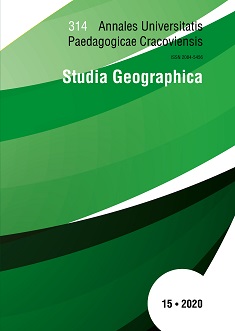The impact of frost heaving on road infrastructure north of Cracow and the possibilities of preventing it
DOI:
https://doi.org/10.24917/20845456.15.14Keywords:
foundation of roads; frost action; frost heave; road surface damageAbstract
Frost actions play a large role in transforming road surface in rural and urban areas. The degree of these transformations is different and it is greater on the lower category roads most often. Despite much greater capacity of national and voivodship roads, we will observe larger changes on poviat and commune roads. It depends on lower financial outlays for proper soil preparation before construction / modernization of such roads. The damage rate for national roads was 0.07 holes in the pavement / km, for voivodship roads - 0.2, for poviat roads - 0.73, and for communal roads - 0.8. To reduce road pavement damage one of several methods is used to limit the operation of frost processes.
References
Bieńka J., Dzienis T., Godlewski T., Kamela R., Radomska E. (2006). Wytyczne zimowego utrzymania dróg. Załącznik do Zarządzenia Nr 18 Generalnego Dyrektora Dróg Krajowych i Autostrad z dnia 30 czerwca 2006 roku, Warszawa.
Ickiewicz I. (2009). Analiza zjawiska wysadziny zmarzlinowej dla celów inżynierskich. Czasopismo Techniczne, 5, 106, 63–70.
Gajewska B., Kraszewski C. (2015). Wybrane metody wzmacniania podłoża. Budownictwo drogowe i kolejowe, 24–29.
Jahn A. (1971). Lód i zlodowacenia. Warszawa: PWN.
Kalkan E. (2009). Effects of silica fume on the geotechnical properties of fine-grained soils exposed to freeze and thaw. Cold Regions Science and Technology, 58, 130–135.
Miyakawa I., Koyama M., Takahashi T. (1963). Frost-heave of roads in Hokkaido, Japan, Permafrost International Conference, 11–15 listopad 1963, Lafayette, Indiana, National Academy of Science, Washington, 497–502.
PN-81/ B-03020. Grunty budowlane. Posadowienie bezpośrednie budowli. Obliczenia statystyczne i projektowanie, Polski Komitet Normalizacji, Miar i Jakości.
Rafalski L., Ćwiąkała M., Gajewska B., Kraszewski C. (2018). Badania związane z podłożem nawierzchni drogowej. Inżynieria morska i geotechnika, 3, 165–170.
Rolla S. (1961). Walka z przełomami na drogach. Warszawa: Wydawnictwa Komunikacyjne.
Rui D., Ji M., Nakamur D., Suzuki T. (2018). Experimental study on gravitational erosion process of vegetation slope under freeze–thaw. Cold Regions Science and Technology, 151, 168–178.
Rzeźniczak J. (2007). Wzmacnianie słabych podłoży. Skuteczność wzmacniania słabych podłoży metodą udarową oraz przez statyczne przeciążenie i odciążenie. Geoinżynieria. Drogi, mosty, tunele, 12 (1), 34–42.
Simonsen E., Isacsson U. (1999). Thaw weakening of pavement structures in cold regions. Cold Regions Science and Technology, 29, 135–151.
Szruba M. (2018). Metody wzmacniania podłoża gruntowego w budownictwie drogowym. Nowoczesne budownictwo inżynieryjne, 4, 61–66.
Szwejkowski Z. (1999). Podstawy agrometeorologii. Wyższa Szkoła Agrobiznesu w Łomży.
Zawisza E., Franczak A. (2010). Wytrzymałość i mrozoodporność stabilizowanych popiołów lotnych. Drogownictwo, 6, 202–207.
Downloads
Published
Issue
Section
License
The submission of a paper to be published is synonymous with an agreement to transfer the copyright free of charge from the author to the publisher. The author also agrees to permit the publisher to publish the paper in printed form, open access online form, digital library form and other digital platforms with which the publisher has or will have a publishing agreement. Furthermore, the author agrees to not limit the number of copies that may be printed or issued by the publisher. In the case of co-authored papers, it is assumed that the corresponding author is authorized to represent the remaining co-authors in this respect. Authors are requested to sign a copyright declaration.

